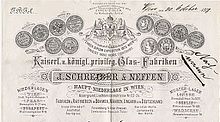J. Schreiber & Nephew
Coordinates: 48 ° 13 ′ 7.7 ″ N , 16 ° 21 ′ 40.5 ″ E
J. Schreiber & Neffen was a glass factory in Austria . The main defeat was at the Liechtenstein Strasse 22-24 in the 9th Viennese district of Alsergrund . There were further branches at Tegetthoffstrasse 3 in Vienna, in Prague at Heuwagplatz 27, in Budapest at Waltznergasse 18, and sample stores in London at Basinghall Street 26, Ritterstrasse 43 in Berlin and Senatorenstrasse 20 in Warsaw.
history
In 1857 Josef Schreiber bought a glassworks in Groß Ullersdorf in Moravia . He had acquired his knowledge in the field of glassmaking in Bohemia. In 1865 Josef Schreiber senior left († 1878) left the company and handed it over to his two nephews Josef Schreiber jun. (1835–1902) and Max (1838–1906) and Eduard Göpfert (1836–1891). At that time, the Schreiber empire included glassworks in Bohemia, Moravia, Hungary, Russian Poland and the German Empire. In 1889 the following glassworks belonged to the company: Reitendorf , Josefsthal , Zay-Ugrocz , Zomkovice, Fürstenberg (Oder) , Heinrich-Hütte , Jaronowitz and Maxhütte . The main office was in Vienna-Alsergrund, Liechtensteinstrasse 22-24.
The company grew rapidly and the products were sold all over the world, mainly to England and America. In 1862 the company received a diploma for good glass quality in London.
At the world exhibition in Paris in 1867 the company was awarded the great silver medal and in 1872 in Moscow at the polytechnic exhibition the gold medal. At the Vienna World Exhibition in 1873 the company presented itself as kkpriv. Glass factories and refineries J. Schreiber und Neffen and received the highest distinction, the honorary diploma.
In 1882 the company had around 2,000 workers and 100 civil servants. New attempts were made in Reitendorf and it was possible to manufacture pressed glass ; at that time this process was only possible in America, England, France and Belgium. A special feature of pressed glass production was the process with optical rollers.
The glass factories also included coal mines for energy production (glass melting). The coal mines Albert-Zeche near Dubnian , as well as Heinrich-Schacht and Richard-Schacht near Luschitz should be mentioned. In the glass factories mentioned, there were a total of 16 ovens, only 3 of which had direct wood heating, while 11 ovens were already heated with gas from coal and 2 with wood gas.
The company's warehouses were located in Vienna, Prague and Budapest. Representations were in Berlin, Leipzig, London, Paris, Trieste, Milan, Warsaw, Kiev, Odessa, Alexandria, Tbilisi, and Melbourne. The company catalog comprised 3,000 shapes in 15,000 sizes.
The very finest service glass was produced in Reitendorf. In addition to the cut, the glass was also provided with decorations, which were engraved into the wax coating using pantograph machines and etched out with acid. Schreiber was the first glass manufacturer in Germany to acquire this patent.
In 1890 Josef Schreiber bought the large Lednicróna estate near Trenčín in order to use its wood. There, too, he built a new glass factory. In 1897, Josef Schreiber converted his company into a stock corporation by means of a partnership agreement, of which he remained president until his death. In 1899, another factory was purchased with the Briesen glassworks .
Josef Schreiber was ill with stomach all his life and died on November 17, 1902. At his own request, his body was buried in a mausoleum in Lednicke Rovne.
After the First World War and the collapse of the Austro-Hungarian monarchy, the decline of the glassworks began vorm. J. Schreiber & Neffen AG . After losing the previous markets, the company sold most of the glassworks or closed them down by 1925. Only the plants in Lednické Rovne and Reitendorf were operated . As a result of the Second World War, the company went out completely. Today only art glasses in the glass museum showcases are a reminder of the company's heyday.
literature
- Göpfert, Eduard: J. Schreiber & Neffen. In: Austrian Biographical Lexicon 1815–1950 (ÖBL). Volume 2, Verlag der Österreichischen Akademie der Wissenschaften, Vienna 1959, p. 17.
- Schreiber, Josef the Elder Ä .. In: Österreichisches Biographisches Lexikon 1815–1950 (ÖBL). Volume 11, Verlag der Österreichischen Akademie der Wissenschaften, Vienna 1999,ISBN 3-7001-2803-7, p. 194 f. (Direct links on p. 194 , p. 195 ).
- Schreiber, Josef the Elder J .. In: Austrian Biographical Lexicon 1815–1950 (ÖBL). Volume 11, Verlag der Österreichischen Akademie der Wissenschaften, Vienna 1999,ISBN 3-7001-2803-7, p. 195.
Web links
- Living and working in the glassworks before the Second World War (PDF file; 21 kB)
- Schreiber family tree on pressed glass correspondence (PDF file; 2.54 MB)


